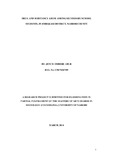| dc.description.abstract | According to the World Drug Report (2005), the use of illicit drugs has increased
throughout the world in recent years. The report further states that a major world trend
is the increasing availability of many kinds of drugs to an ever widening socioeconomic
spectrum of consumers. Findings from a National Survey on Alcohol and
Drug Abuse conducted by NACADA in 2012 shows that 13.3% of Kenyans are
currently using alcohol, 9.1% tobacco, 4.2% miraa, 1.0% bhang and 0.1% heroin.
Overall, bhang is the most easily available illicit drug in the country at 49% followed
by cocaine while heroin is the least available illicit drug in the country.
According to a national survey on the Rapid Situation Assessment of Drug and
Substance Abuse in Kenya (2012), 11.7% of youth aged 15-24 are current users of
alcohol, 6.2% tobacco, 4.7% miraa and 1.5% cannabis. In addition, the median age of
initiation among the 10-14 year olds to tobacco and alcohol is 10 years. These
statistics are an indication of the grave situation faced by children and the youth who
are already burdened by other socio-economic challenges such as unemployment. In
the Standard Newspaper of June 26th it was reported that Kenya is alarmed over
millions of youth wasted by drugs in the Capital City of Nairobi. That the Statistics
showing high rates of alcohol and drug abuse among the youth have forced the
Government to take drastic action on the peddlers. . It is in this background that this
study sought to find out the extent to which drugs are being abused in schools and the
level of confidence there is among young Kenyans in school in engaging in drug
abuse.
The study objectives were to identify the commonly used drugs among the secondary
schools students, find out the sources of the commonly abused substances and their
influence on academic performance, establish the extent of substance abuse and
analyze the level of self-efficacy among these students.The study was guided by
Merton’s Goal-Means Gap theory and Cohen’s Status Frustration theory. This was a
survey with 360 students selected for the study.
The main findings of the study were the commonly abused drug in schools included
marijuana, tobacco, Miraa, Khuber, Glue, Cocaine and Heroin. Using the Bandura’s
self-efficacy scale, the study found out that most students were highly certain that
they can solve difficult problems, accomplish their goals, deal efficiently with
unexpected events and also handle unexpected or unforeseen situations when using
drugs. Centrally to that the same students had a negative opinion towards drugs. This
contradiction is explained that there are situations where people are aware of the
dangers in their behaviour: the self-harm and para-suicides are this category.
One of the major recommendation made is that the issue of drug abuse among the
youth should remain on the agendas of policy makers in the country, especially
elected leaders, so as to maintain long-term commitment to solving the drug problem.
This could include advocacy, creating awareness, and meet-the-people campaigns. | en_US |

